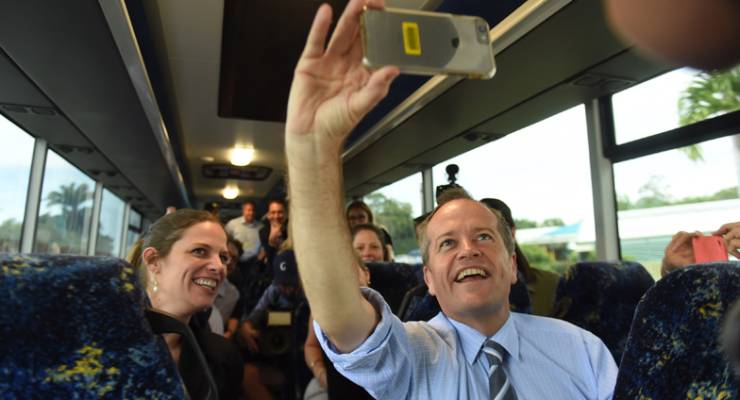
If a politician is kissing a baby and no one is around to report on it, has the baby really been kissed at all?
This week, and perhaps for a few more, The Sydney Morning Herald and The Age have pulled their reporters from the campaign buses. Fairfax photographers will continue to provide a visual record of the campaign, but for now, none of the Fairfax press gallery scribes will turn up to press conferences around the country as the contenders go town-to-town pitching for votes.
“Fairfax Media is still travelling with the leaders,” said federal editor and Canberra bureau chief Bevan Shields. Snappers Andrew Meares and Alex Ellinghausen are still there — Shields says they have “years of experience covering elections and federal politics, and are filing unrivaled images and video from the campaign every hour”.
“We have dozens of reporters spread across our newsrooms in Canberra, Sydney, Melbourne, Brisbane and Perth providing what I think is the nation’s best political coverage. We’ve had a great response from our readers and subscribers so far,” he said.
“We’re only into week three of an eight-week election campaign and have many more exciting things to come ahead of July 2. I think there’s never been a more exciting time to cover an election campaign.”
The length of the campaign appears a key reason for the pull-back. Crikey understands other news organisations have been having similar discussions about the campaign buses and whether it’s worth having reporters on them the whole eight weeks.
As Crikey and others have previously pointed out, going on the buses is expensive. In the Saturday SMH, Latika Bourke suggested a $40,000 to $50,000 figure to send a single journalist on the trail. The buses and planes are chartered by the parties, but the cost of this, as well as of the five-star hotels they stay at, are paid by the media. But despite Fairfax’s general belt-tightening, the withdrawal isn’t about costs, sources say; it’s more an editorial judgement about how best to provide coverage of a long campaign.
Several opinion pieces in Fairfax have recently questioned whether the campaign buses are worth it. Bourke’s piece covered what reporters can expect:
“They will get a few hours of access to the leader at drinks one evening and five minutes on the bus when the leader decides to jump on to schmooze — if they’re lucky. At worst they will be told five minutes before a media conference of the major policy that’s being announced.”
And earlier, the Financial Review‘s political editor Laura Tingle lamented the stream of inanities from the trail on social media. Tingle wrote:
“Media organisations have, as usual, sent their young journalists out ‘on the trail’ with the leaders. They are under pressure to file anything that moves. The pressure to file is only the greater because the relative cost of the travel has risen exponentially when compared with disappearing revenue bases.”
The current model with campaign coverage is for the senior reporters to stay in Canberra, filtering out the trivial when writing their more authoritative pieces, while the juniors do the grunt work reporting everything that happens day to day.
Because of this, it can seem like the on-the-ground reporters don’t contribute much. But those on the buses defended the value in going on the trail when we asked.
Without reporters on the buses, it can be hard for a news organisation to put pressure on the campaign to answer questions. Responses to questions from campaign HQ are scripted and carefully vetted, so catching a politician at a door stop remains the best way to force them to react or respond to a story. Everyone, including the senior oracles in Canberra, watches the press conferences. And it’s up to the trail reporters to ask the questions.
It’s also useful to get a sense of, and spend time with, a politician’s staff, as well as the general feeling of the leaders, another said. A lot of contacts and a lot of impressions can only be built by being there in person, not from watching a newsroom television.
But is that worth losing reporters to hours in transit every day, going from venue to venue at the mercy of the parties? For a week or two at least, Fairfax has decided not.








Here’s a novel idea for the Oz media: instead of being embedded on the same transport & in the same hotels as the party leaders stay home to report, compare, debate & dissect their policies. Cover the actual policies not the politicking.
Or is that not as relevant as Shorten being confronted by an over-enthisiastic South Australian for a pash?
stay at home; policies, not personalities. Try to remember the election is not a sporting contest!
Would we care if they stopped reporting. It’s probably better covered only over the last 2 weeks anyway. I doubt I will see much news coverage that doesn’t start with coverage of a politician talking to a local, or some equally pithy piece of flotsam, but who cares.
On the other hand, getting rid of Michael West from the business pages of SMH! That’s something that will make me think twice about buying their damned paper. If it wasn’t for the Monday TV guide I probably wouldn’t have bought today’s!
I’m for the Bishop Berkley proposition – they are OUR servants, they should speak to & for (HA!) us.
The idiocies of flouro vests and ‘pointing at stuff’ was demonstrated to be beyond satire by the Abbotrocity… and yet, and yet, the mudorc meeja won him an election, despite suppositories & raw onions.
I’d attend a town hall meeting but Hewson showed that was a bad idea.